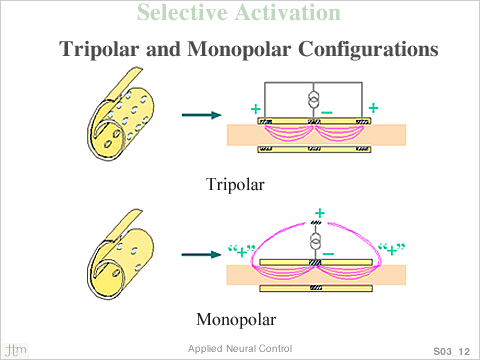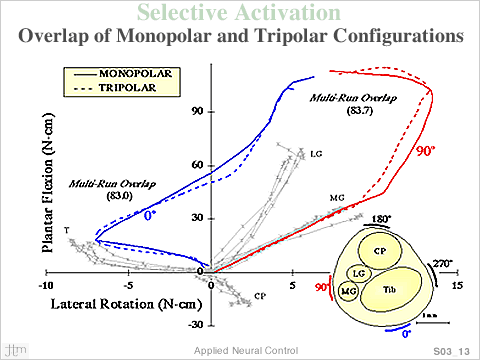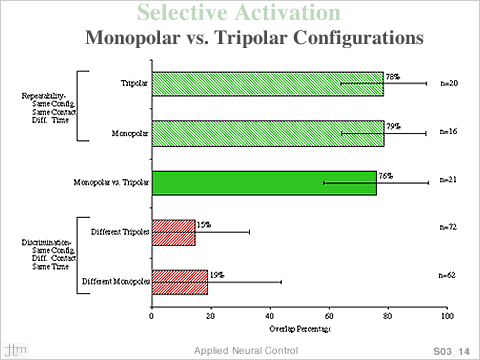|
|
|
| |
|
|
|
|
|
 When
multicontact cuff electrodes are placed around a peripheral
nerve, the contacts may not be aligned with target fascicles.
With multiple available contacts, virtual excitation sites
can be created by superimposing the electric fields generated
by simultaneous application of currents to two or more contacts
in the electrode assembly, “field steering”. When
multicontact cuff electrodes are placed around a peripheral
nerve, the contacts may not be aligned with target fascicles.
With multiple available contacts, virtual excitation sites
can be created by superimposing the electric fields generated
by simultaneous application of currents to two or more contacts
in the electrode assembly, “field steering”.
Field steering has been explored as a technique for creating virtual excitation
sites that are different from the physical location of an actual stimulating
contact [1]. These were carried out with self-sizing spiral cuff electrodes,
containing four radial contacts, implanted on feline sciatic nerve. The feline
sciatic nerve is ~3mm in diameter and contains four major motor fascicles. In
about two-thirds of the tests one of the four contacts was positioned to excite
selectively and controllably one of the four motor fascicles in the sciatic nerve.
In those cases where a single contact could not activate a target fascicle, field
steering was shown to be an effective means of creating a virtual excitation
site confined to a target fascicle.
Monopolar and tripolar-cuff electrode configurations and schematics of the resulting
current flow are shown in the figure. With the tripolar configuration (above),
the current flows between the center contact (cathode) and the two outer contacts
(anodes). With the monopolar configuration (below), the current flows between
the central contact (cathode) and the remote contact (distant anode), creating
a virtual anode at each end of the cuff.
[1] Tarler, M. D. and J. Thomas Mortimer (2003) Comparison
of Joint Torque Evoked With Monopolar and Tripolar-Cuff
Electrodes. IEEE Tran. Neural Systems And Rehab.
Eng., Vol. 11: 3, pp 227 – 233.
|
 Both Monopolar and Tripolar configurations can be used to create virtual excitation sites or tunable electrodes. The experiments described here were intended to bring out any differences in the recruitment characteristics between the two electrode configurations. The coordinates of the plot, shown at thein the Figure left, are ankle torques in two dimensions, Planter Flexion/Dorsi-Flexion and Medial/Lateral Rotation. Data shown are for evoked ankle torque resulting from stimulation applied to various contacts within a self-sizing spiral cuff electrode. Also shown in this figure are torque measurements recorded when stimuli were applied to each of the four isolated motor nerves, labeled T, CP, MG and LG and (shown asby grey lines). The drawing, shown in the lower right hand portion of the figure, provides an approximation for the nerve anatomy relative to the position of the four electrode contacts labeled O¾, 90¾, 180¾ and 270¾. Single dots represent data collected at different stimulus levels. In this experiment, the Medial Gastrocnemius (MG), the Lateral Gastrocnemius (LG) and the Tibialis (T) branches were selectively activated over thereir full range by contacts 90¾, 180¾ and 0¾ respectively. Stimuli applied to the 270¾ contact appeared to activate both the tibial and common peroneal fascicles. Both Monopolar and Tripolar configurations can be used to create virtual excitation sites or tunable electrodes. The experiments described here were intended to bring out any differences in the recruitment characteristics between the two electrode configurations. The coordinates of the plot, shown at thein the Figure left, are ankle torques in two dimensions, Planter Flexion/Dorsi-Flexion and Medial/Lateral Rotation. Data shown are for evoked ankle torque resulting from stimulation applied to various contacts within a self-sizing spiral cuff electrode. Also shown in this figure are torque measurements recorded when stimuli were applied to each of the four isolated motor nerves, labeled T, CP, MG and LG and (shown asby grey lines). The drawing, shown in the lower right hand portion of the figure, provides an approximation for the nerve anatomy relative to the position of the four electrode contacts labeled O¾, 90¾, 180¾ and 270¾. Single dots represent data collected at different stimulus levels. In this experiment, the Medial Gastrocnemius (MG), the Lateral Gastrocnemius (LG) and the Tibialis (T) branches were selectively activated over thereir full range by contacts 90¾, 180¾ and 0¾ respectively. Stimuli applied to the 270¾ contact appeared to activate both the tibial and common peroneal fascicles.
|
|
Quantitative comparisons of the torque trajectories recorded
for the monopolar and tripolar configurations have been made
using a method developed by Tyler and Durand [1] to compare
two torque curves in space. The similarity of two recruitment
curve was defined as the percent of one curve that was not
statistically different from a second curve at a 98% level
of confidence. The 98% confidence level for the data may
be found using the Student’s t distribution and the
standard deviation of points achieved by supra-maximal stimulation
of the nerve. Results achieved after supra-maximal stimulation
were selected since, by definition, no additional torque
may be achieved and therefore any variability in the measured
torque was a characteristic of the experimental system and
not due to changes in the number of fibers activated. Using
the 98% confidence level, each point along one curve, the
test curve, was tested against each point on the other curve,
the reference curve.

A summary of the similarity of values found for monopolar
and tripolar configurations is shown in the figure. The similarity
achieved using the same tripolar configuration at different
times (above) and the similarity achieved using the same
monopolar configuration at different times (second from top)
were found to be 78% and 79%, respectively. The monopolar
output torque compared to the tripolar output torque (middle),
at a value of 76%, was not found to be significantly different
than either the monopolar or tripolar repeatability at a
98% confidence level. The similarity values found for the
torque outputs produced by stimulation applied to two different
locations around the nerve were found to be 19% and 15%,
respectively. The number of comparisons (n) was equal to
the sum of every combination of two trials that satisfied
the comparison of interest.
[1] Tyler, D.H. and D.M. Durand (1997) A Slowly Penetrating
Interfascicular Nerve
Electrode for Selective Activation of Peripheral Nerves.
IEEE Trans. Rehab. Eng. 5: p. 51-61.
|
|
|
|
|
|
|
|
|

